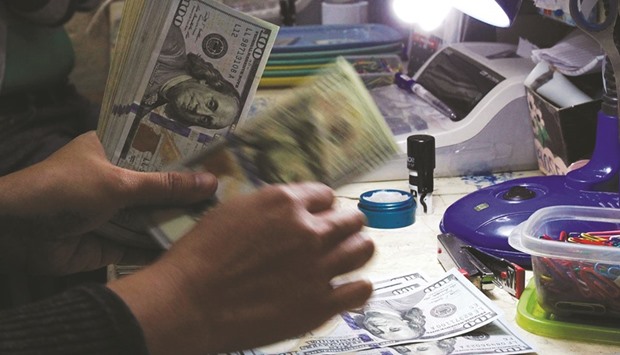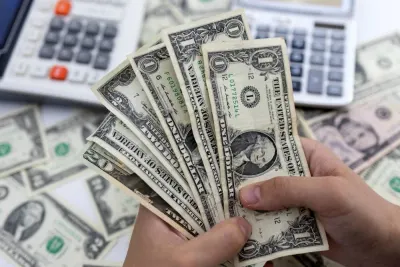How much has the dollar appreciated? That depends in which of the 50 US states you ask the question.
To the global audience, the US currency appreciated about 11% last year against a large group of major trading partners. But the Federal Reserve Bank of Dallas has compiled data to create a map of the dollar’s trade-weighted performance state-by-state, and the differences are striking. In Florida, it rose just 3% last year, compared to more than 14% in the Dakotas, where exports to Canada were hit by slumping commodity prices.
In Europe, the divergence between the 19 nations who share the euro common currency is part of the daily discussion. That’s not how the outside world is generally thinking about the US Fed officials make policy on a national basis, but are probably not blind to the regional differences and the risk that raising interest rates could leave part of the country behind.
“The Fed is aware that the pain from a strong dollar is a lot worse in some parts of the country than the headline suggests,” said Gennadiy Goldberg, an interest-rate strategist in New York at TD Securities. “That’s another reason to watch financial conditions.”
The policy-setting Federal Open Market Committee holds its next meeting on March 15-16. Policy makers including Chair Janet Yellen have indicated that headwinds from abroad that have sparked financial market turmoil may delay rate increases if such spillovers damp the US economic outlook.
“The strength of the dollar really is putting a lot of stress on a lot of exporters right now, more so in some states than others,” said Keith Phillips, senior economist at the Federal Reserve Bank of Dallas. “A positive upshot is that anytime you have pressures like these on manufacturers, they become very innovative in reducing their costs - they come up with ways to produce at smaller costs and that creates more productivity.”
3M Co, the Minnesota-based maker of Post-it notes and Scotch tape, overhauled its operations last quarter to reduce US expenses and strengthen its business in Europe and Latin America, to help offset a stronger dollar. Honeywell International, a worldwide diversified technology and manufacturing company based in New Jersey, has cut costs and improved efficiency to boost profit.
Currency appreciation could make itself felt in the political arena if it cools economies in swing states like Ohio, where the trade-weighted value of the dollar rose 13.5% last year, or Michigan where it advanced 13.7%. Both have jobless rates near the national level, but employment reacts with a lag to economic activity.
Exports account for some 14% of US gross domestic product, with shares ranging from less than 1% in Hawaii to about 25% in Louisiana - one showcase of diversity within the US that affects how monetary policy trickles through in different regions.
In Europe, divergences are well discussed. While unprecedented efforts to spur activity by the European Central Bank have led to above-trend growth in Germany, peripheral economies such as Greece are still struggling to recover, remaining dependent on ECB stimulus and a weak currency. The euro depreciated 5.6% in trade-weighted terms last year.
The dollar’s ascent in 2015 was the steepest since 1997. The spread between the weakest and strongest appreciation among the US states was 11 points, the widest since 2008, when the collapse of Lehman Brothers Holdings caused havoc in financial markets.
The gap had narrowed in recent years, from 29 points in the late 1990s to less than 10 points.
“Diversification is key,” said Mark Vitner, senior economist at Wells Fargo Securities in Charlotte, North Carolina. “What states should do is try to make sure that they export to a wide assortment of countries, that they’re not tied to the fortunes of any one or two nations.”
Export diversification paid off last year. States where the top three foreign trading partners made the smallest contribution to overall exports also saw some of the mildest currency appreciation. Florida, whose trade-weighted dollar advanced the least of all states last year, shipped 21% of its goods to its three most important destinations, according to 2014 data, which is the most recent available. Louisiana and Nevada were similarly successful in weathering a stronger dollar.
At the other end of the spectrum were North and South Dakota, where the top-three export destinations accounted for 86% and 70% of trade, respectively.
Canada was the top trade destination for 35 US states last year and the 16% slide in its currency as energy prices slumped had a big impact on the trade-weighted value of the dollar on a state-by-state basis.
In the US, where recent data on jobs, consumer spending and inflation have been mostly positive, policy makers are debating how much tightening the economy can stomach despite the stronger dollar.
“It’s not that they ignore what’s going on in the rest of the world,” said Wells Fargo’s Vitner, but “ultimately they have to do what’s best for the US economy.”

A money changer counts the US dollar bills at a currency exchange in Manila. The dollar’s ascent in 2015 was the steepest since 1997. The spread between the weakest and strongest appreciation among the US states was 11 points, the widest since 2008.


